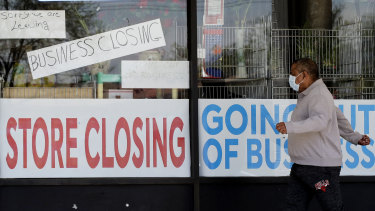Debt doom loop on the cards once COVID is contained
The world economy will be exiting the pandemic weighed down by much bigger debts and increased inequality that could hobble growth in the longer term.
That was one of the memes making the rounds at the annual meeting of the American Economic Association this week.
While global growth is widely expected to strengthen as more people are vaccinated, top economists at the virtual three-day conference focused on the glaring inequities that the pandemic had exposed and the fallout from the efforts to cope with and combat the coronavirus pandemic.

“We have met every crisis in the recent past with yet more aggressive central bank accommodation and yet more leverage, both public as well as private,” said former Reserve Bank of India governor Raghuram Rajan.
“The real question is: Is this a doom loop? Does it keep going until it is forced to stop?”
Global debt rose by more than $US15 trillion ($19.3 trillion) last year to a record $US277 trillion ($357 trillion), equivalent to 365 per cent of world output, according to the Institute of International Finance. Debt from all sectors – ranging from household to government to corporate bonds – surged, based on data from the Washington-based IIF, which is constituted of the world’s leading financial institutions.
Inequality has also increased as the pandemic has hit the poor particularly hard. In the US, Blacks and Hispanics have suffered proportionately more fatalities than Whites, while low-wage workers in such industries as leisure and hospitality have borne the brunt of the layoffs as those better off continue to work from home.
“The pandemic has exposed the depth of inequality and in many ways has exacerbated those inequalities,” said Joseph Stiglitz, a Nobel Prize-winning economist.
While rich countries such as the United States have cushioned the blow to their citizens with large amounts of government aid, poorer nations have been unable to do that. Stiglitz, a Columbia University professor, said the world’s 46 least developed nations accounted for 0.002 per cent of the $US12.7 trillion ($16.4 trillion) in public stimulus spending laid out in the fight against the virus.
“In many ways we could see after this pandemic an unwinding of decades of progress toward reducing global inequality,” certainly for the poorest nations, said Harvard University professor and former International Monetary Fund chief economist Kenneth Rogoff.
Not everything coming out of the pandemic will be bad news, of course. The speed at which vaccines were developed and the rapid growth of telemedicine are developments worth celebrating.
Economist Nicholas Bloom of Stanford University has also pointed to the potential productivity gains that can be reaped from more time spent working at home – a trend he expects to persist after the pandemic. Rajan, now a professor at the University of Chicago, said lagging rural America could also benefit as the well-off decamp from cramped cities for bigger homes elsewhere.
Even before the pandemic, the US, China and many other countries were experiencing rising inequality and increasing debt. As the coronavirus crisis eases, those two tendencies could combine to present problems for the global economy.
The pandemic has “exacerbated inequality markedly which also raises the issue of financial fragility,” said World Bank chief economist Carmen Reinhart.
Many lower-income US households, for example, hold a lot of debt and could find themselves squeezed as temporary moratoriums on mortgage and rent payments end, she said.

Rajan said small businesses could also suffer after many were kept afloat in the US by the Paycheck Protection Program and other government measures. “There is a large wave of potential bankruptcies,” he said.
The problem is even more acute for some emerging market economies and poorer nations. Indeed, Stiglitz sees the “risk of a debt crisis with global consequences.”
“Many countries were over-indebted before the pandemic and the marked declines in their incomes mean they’re going to have difficulties servicing the debt,” he said.
The US and other wealthier nations will not be immune to having to take action to rein in surging government debt once the coronavirus crisis has passed, according to former White House chief economist Christina Romer.
The US budget deficit will hit $US2.3 trillion ($3 trillion) in the fiscal year ending September 30 – equivalent to more than 10 per cent of gross domestic product – following a $US3.1 trillion ($4 trillion) shortfall in fiscal 2020, according to the Committee for a Responsible Federal Budget.
“When we are through the pandemic we are going to need to get our fiscal houses in order,” said Romer, who is now at the University of California at Berkeley. “We’re going to need to get our debt loads down mainly so we’ll be in a position to deal with the next crisis, pandemic, or whatever when it comes.”
Bloomberg
Business Briefing
Start the day with major stories, exclusive coverage and expert opinion from our leading business journalists delivered to your inbox. Sign up for the Herald‘s here and The Age‘s here.
Most Viewed in Business
Source: Thanks smh.com